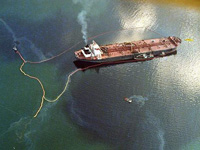Still Much Oil Left in the Ground after Exxon Valdez Tanker Disaster
Explaining the reason behind the persistence of oil along miles of Alaska’s gravel beaches even two decades after the Exxon Valdez tanker disaster in Prince William Sound, scientists said that the oil is trapped between the rocky top layer and the gravelly lower layer of the beaches of Prince William Sound.

According to the report, published in the Sunday edition of Nature Geoscience’s online publication, nearly 21,000 gallons of oil – out of the 11 million gallons of spilled by the tanker in 1989 - still remain on the garvel beaches.
As per Boufadel, the spilled oil was evidently broken up and dissipated by water, allowing it to gradually travel through lower level of gravel, where it remains trapped owing to the suitable underneath conditions.
Noting that the finer-grained gravel, aided by the tidal forces, created an almost oxygen-free low nutrient-level to facilitate the slow biodegradation of the oil, scientists said: “The oil could be maybe one foot below the beach surface and in contact with sea water with a lot of oxygen, but the oxygen doesn't get to it.”
The study, explaining why the spilled oil is not degrading as much as expected, would have notable implications on future attempts to remove residual oil – a proposal that the state and federal prosecutors put forth in 2006, and is still being negotiated with Exxon Mobil Corp.
TopNews United States has contributed to the report.
Subscribe to Pravda.Ru Telegram channel, Facebook, RSS!





